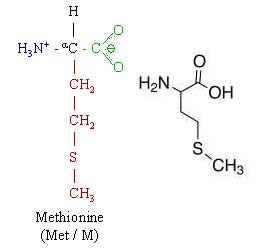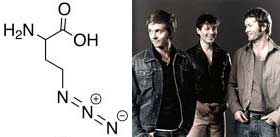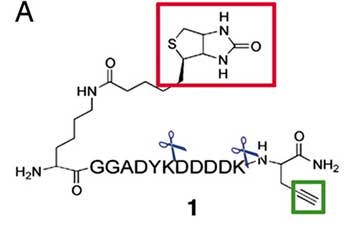|
Wednesday, July 12, 2006
Not only have I forgotten my high school French, but also I have forgotten my undergrad organic chemistry. More accurately, I never bothered to learn it very well. Imagine my dismay, then, when I discovered that it might actually come in handy for answering important memory questions. Dieterich et al (2006) recently reported the use of a technique called BioOrthogonal NonCanonical Amino acid Tagging (BONCAT) to see what proteins a cell has made lately. You can use mass spectrometry to find out what proteins a cell has in it in total, and you can use radioactively labeled amino acid incorporation to label recently synthesized proteins, but the great thing about BONCAT is that you can specifically pull the newly synthesized proteins out of the mix and subject them to mass spec analysis, greatly simplifying your sample and increasing your signal-to-noise ratio.
This technique is not entirely new. The foundations were established in 2002, but this is the first use in mammalian cells. They don't go into much detail about the potential uses, but I'm betting I can guess why Erin Schuman got involved. She has put plenty of time and effort into showing that local protein synthesis at synapses is a key process in producing long-lasting plasticity. The obvious question of which proteins are being synthesized is currently being answered tediously, one protein at a time. It is no surprise then that one of the two mammalian cell lines that they tested their reagents on to check for toxicity was cultured hippocampal neurons. What follows could probably be classified as 'hard-blogging', so if you don't feel like briefly reviewing amino acid structure and learning about cycloadditions you should probably click here instead. I really just want to give you a vague idea of how the technique works. I'm sure we'll get some data from Schuman before too long telling us about synthesis of synaptic proteins, and then I can link back here. Let's start somewhere near the beginning. Proteins are made up of chains of amino acids. There are 20 naturally occurring biological amino acids, unless someone has snuck some in behind my back. Here are two illustrations of an amino acid called methionine:  Note that in the 'stick-figure' version there is a blue group on the left with a nitrogen in it. This is the amino group. The green group on the right with a carbon and two oxygens is the carboxylic acid group. Amino + Acid = amino acid. Every amino acid has these two functional groups and proteins are strung together by attaching the carbon of the carboxylic acid to the nitrogen of the amino group via a 'dehydration synthesis' step to produce a peptide bond. The long chain hanging off the bottom is called the 'side chain'. It is what differentiates one amino acid from the next. For BONCAT, they just made up a new amino acid called azidohomoalanine (AHA), pictured here:  When AHA is washed over cells, it calls to them, "Take me up!" They, of course, comply and treat AHA like their very own amino acid, methionine. So if you give cells AHA and wait a while and then harvest the proteins from those cells, only the recently synthesized proteins will have AHA in them. Since AHA has that nice little tres nitrogens group (the azide) hanging off of it, it is capable of some special chemistry. See, it's nice to have the new proteins labeled with this funky amino acid, but we want to pull them out of solution and figure out what they are. To do that the authors have to attach something to AHA that they can pull on. A "trypsin-cleavable biotin-FLAG-alkyne tag 1" should do the trick! Since I don't really understand what everything in there is for I am going to concentrate on the parts I do think I understand: the alkyne (in the green box) and the biotin label (in the red box).  When you mix the proteins from AHA-treated cells with the tag in the presence of copper bromide, the azide group hooks up with the alkyne in a Huisgen cycloaddition reaction. For us, all that matters is that the newly synthesized proteins get attached to the tag. The whole mess is then run through a molecular gauntlet containing a resin that is particularly sticky for biotin (the red box). All the old, played out proteins can get outta here, but the new fresh isht gets to stay. Now you have a resin with freshly synthesized proteins stuck to it. You can release these when you please, I think, by dropping in a protein that does what those scissors are doing in the above picture. So finally you have a solution of just the proteins you really like. Tandem mass spectrometry is a whole other complicated topic. In short, the solution is put into a machine that sorts the proteins by size and then blows them up and sorts the fragments by size too. Then a magical algorithm puts all the fragments back together to figure out which proteins were there. Using this technique in human kidney cells that hung out with AHA for 2 hours, Dieterich et al. were able to identify 195 newly synthesized proteins with all sorts of biochemical properties and cellular tasks. This is a lot better than doing it one protein at a time. Hey, I have an idea. Maybe since AHA isn't toxic to hippocampal neurons we could try BONCAT with neuronal proteins that are laser-captured from recently stimulated synapses. That settles it. I am a genius of experimental design. Please contact my agent to confirm the address for delivery of my Nobel. Thank you very much. |



